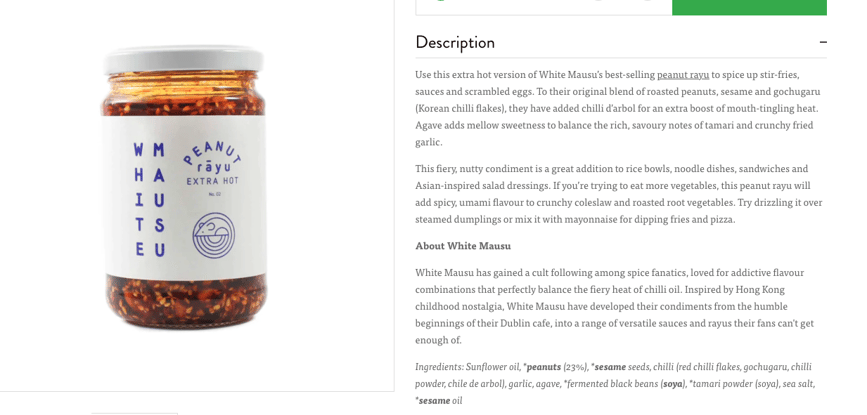
It’s easy to leave writing product descriptions as an afterthought. We totally get it — most stores have a fair few to write, after all.
But while your product descriptions needn’t (and shouldn’t) be very long, they do require some thought, some time, and even some redrafting. Because in the absence of being able to see and hold a product in real life, your product descriptions are working overtime — and it’s important to get them right.
In this post we’ll walk you through some product description best practices to bear in mind when crafting your own. Before long, it’ll be second nature.
9 Product description best practices:
- Know who you’re writing to
- Paint a picture
- Include all the key information
- Optimise for SEO
- Be assertive
- Keep it concise and digestible
- A/B test where you can
- Try out different mediums
- Harness the power of social proof
How to write an effective product descriptions: final thoughts
1. Know who you’re writing to
As a store owner, you’re best placed to know your customers, and how they like to interact. Chances are you’ve emailed them, replied to them on social media, and hopefully you have a rough idea of their demographics from your online store analytics, or Google Analytics.
You know your audience, so stick to your guns when it comes to writing for them. Don’t drift into that trendy Gen Z tone (‘we’ve got you covered!’) if you know you have a Boomer audience who like things a bit more by the book .
Write down everything you know about your typical customer, and give them a name. This is your user persona, and you should always imagine you’re writing for them specifically — this will help you stay on track.

This luxury supplements brand builds trust and a sense of quality and luxury with a calm, clear tone, and use of words like 'innovative', 'pioneering', and 'exclusive', appealing to people who only want the best, no matter the cost
2. Paint a picture
As we mentioned up top, your product descriptions have a lot to tackle. When a customer can’t touch, hold or smell a product, you need to fill in those sensory blanks.
While going too overboard with your product descriptions can make them sound gimmicky, they do need to bring a bit of ~atmosphere~. It sounds cliche, but remember you’re selling an experience, rather than a product.
3. Include all the key information
But don’t get so carried away with painting a picture that you forget to include all the key information. And when we say key information, we mean what’s key for your customers.
Let’s take a plant pot as an example. Your customers probably won’t care for an exact measurement of how thick the pot is, but they’ll definitely want to know how wide the opening is (to make sure their plants will fit).
And if (like me), you’re a tall girl looking for a low-ish pair of heels, it’s all very well to be told how amazing you’re going to look wearing them — but if the box arrives and they turn out to be five inches too short, they’re getting sent straight back.

ASOS breaks out its product information into helpful sections, including a size guide and the model's measurements for comparison
4. Optimise for SEO
If someone googles ‘neon pillar candles’, and you happen to sell neon pillar candles, it would be great if your website was listed near the top. SEO stands for Search Engine Optimisation, and basically encompasses everything you can do to give your products the best possible chance of this happening.
These things don’t happen by accident. While there are a ton of factors that go into deciding which pages appear above others (we’ve rounded up the most important ones in our guide to SEO for ecommerce), simple tweaks to your product descriptions can have a big impact.
It’s basically all about aligning what you’re writing with what people are actually searching for, which makes it easy for Google to see that your product is relevant. You can use a free tool like Google Keywords Planner to find out what people are searching for (these are called keywords), and then weave these into your product descriptions.
📚 Find out more: 6 Changes to Make On Your Product Pages for SEO
5. Be assertive
No no, not in a ‘buy these shoes now!!’ kind of way. Well-written product descriptions are assertive, but without being pushy.
Write confidently. Cut out ‘might’s and ‘should’s; ‘These heels are comfortable enough to wear all day, and then out for drinks afterwards’ is a lot more convincing than ‘These heels should be comfortable enough…’.
See how it doesn’t feel pushy, even though we can’t technically vouch for the fact that everyone will find them that comfortable?

Notice how this description starts with 'Use this...'? It's technically a command, rather than a suggestion, but it doesn't feel at all aggressive or out of place - just assertive and confident in the product, and where it'll shine
6. Keep it concise and digestible
By this point we’ve added a lot to your product description. And now, it’s time to take some of it away. Look back over your product description and ask yourself: is everything here for a reason?
Nothing-y phrases like ‘very high quality’ should be the first to go. They’re so commonplace now that they’re practically meaningless, and just the kind of thing we write when we can’t think of something better.
Structure-wise, a huge wall of text is unappealing to the eyes of modern internet surfers, with famously short attention spans. Try splitting it out into smaller paragraphs, and introducing bullet points and different formatting to break it up.
7. A/B test where you can
Marketing is a humbling activity; all too often you’ll find that what you think of as your best work doesn’t actually land the way you thought it would.
That’s why it’s important to keep testing, and monitoring. In an ideal world, that means A/B testing your product descriptions.
An A/B test involves splitting your audience in half, and showing a different version of the page to each half. This makes it really easy to see which converts better, and pick a winning formula to roll out to other pages.
The problem is most tools recommend that each version of a page reach about 5,000 views before you can claim a result is statistically significant, and A/B testing tools also come at a price. If you’re not yet at a point where you can justify this cost (or achieve the traffic), you can still get a sense of what’s working by making the change and monitoring conversion rates before and after (this is sometimes called an A/A test).
💡 Top tip: A/B testing is generally a lot easier on email; the results are instant, and it’s a function that your email marketing platform may already include in your current plan (or for a relatively cheap upgrade). It’s not a perfect way to test your product descriptions, but it is a good way to test what language resonates best with your audience — what makes them click through to your site, and open your email?
8. Try out different mediums
As the old saying goes, a picture is worth a thousand words. So while it’s important to give your product descriptions a lot of love and attention, make sure you aren’t neglecting the other elements of your product page — particularly those that could take the pressure off your description.
High quality images taken from different angles and distances can communicate a lot about texture, material, size and finish. For fashion items, a product video goes one step further, showing off the cut, fit and movement of the piece. Generally speaking, product descriptions have more room to be brilliant and engaging when they don’t have to cover a million and one details, because they’re already being covered elsewhere.
9. Harness the power of social proof
Social proof describes the human tendency to follow what other humans are doing. Basically, we’re all sheep at heart.
Social proof is a really powerful persuasion technique to work into your product descriptions, and onto your product page. Did you know the majority of people read between one and ten reviews before making a purchase?
There are plenty of plugins for displaying reviews on your site (and we recommend trying them).
But for your product descriptions specifically, there are other ways to bring in social proof.
- Has this product won awards?
- Was it your best selling [tshirt, ring, hat] from last month?
- Has someone famous worn or used it?

We don't even need to point out how effective the use of 'award-winning' is for this serum - the proof's right there in the sold out status!
How to write an effective product descriptions: final thoughts
Writing great product descriptions is part art and part science; follow the steps above, but don’t be afraid to try something a bit bolder if you think it’ll resonate with your audience. Remember, you know them better than anyone!
As you get into the swing of writing product descriptions, the process should become a lot easier and quicker, but you also risk things getting a little stale. That’s why our last top tip is to take a screengrab any time you see a product description that catches your attention, and keep them together in an ‘inspiration’ folder. That way you always have somewhere to look when your natural inspiration reserves run dry.
Got a super effective product description technique, or top tip? Share it in the comments below!
Not registered with CREOATE yet? Sign up now and shop wholesale with us today.
FAQs
How long should a product description be?
We'd recommend making your product description around 300 words long, but making it easy to skim by including key bullet points at the top. 300 words is a good count to average for both SEO purposes and general thoroughness - but of course, some products may need more, while other more self-explanatory products will be fine with less.
How can I find keywords for my product descriptions?
Google Keyword Planner is a good tool to use for basic keyword planning. Start by searching the most relevant way to describe your product, such as 'glass jar candle', and check which is the most commonly used phrasing (so which keyword has the highest search volume). Try to weave in semantically similar terms from the list where possible, too.
Related posts:








